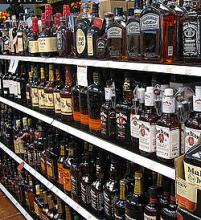Today is Independence Day in the United States, a holiday when we yankee folks recall our country's successful bid for autonomy from our colonial rulers in the English crown over 200 years ago. It's a day to celebrate liberty and all the things we love about our nation. While there are a lot of things to appreciate about America (its dense cross-section of different cultures, its unparalleled contribution to the art of film and its varied landscape to name a few), one of my personal favorite things about our sovereign union is its most popular native liquor: Bourbon whiskey. A lot of cultures have a unique variety of whiskey to their claim and it's for that reason that America has bourbon today. Many of our 18th century immigrants were of Scottish and Irish descent, so they brought their craft for whiskey making with them to these shores. There's a very interesting history to just how bourbon became the whiskey Americans know and love today. It involves war, two great historical figures and a staple of American agriculture.
The story of bourbon begins in the mid-1700's when recent European settlers in the pre-Independence colonies of America began using their surplus rye crops to make whiskey in regions like Pennsylvania and Virginia, adding a new local flavor to tavern shelves alongside other American favorites like Applejack and wheat ale. After the Revolutionary War, the fledgling Congress began collecting taxes on such luxuries as distilled spirits, a notion that didn't sit too well with those Pennsylvanian whiskey makers. They violently opposed the new tax, thus beginning the so-called Whiskey Rebellion, a conflict that lasted three years. President George Washington opted to switch from military force to revenue-producing settlement incentives to quell the rebellion. In conjunction with Thomas Jefferson, then the Governor of Virginia and the region known as Kentucky prior to the establishment of Kentucky as a state, President Washington offered the rebelling rye farmers a plot of land in Kentucky in exchange for an agreement to raise native corn in the soil. And where there's corn, there's corn-based whiskey.
It wouldn't be until the 1960's that the US government would regulate what actually constitutes bourbon whiskey but ever since that late 18th century move to Kentucky, much of America's local whiskey has been made of at least 51% corn mash. This corn content makes for a characteristically sweet whiskey and allows for a fair amount of variation in different brands. Some bourbons are sweeter and more syrupy than others, while others favor a more Irish-leaning bite and burn. The distinctive caramel color in bourbon comes from its time aging and mellowing in charred oak barrels, a process often credited to a Bourbon County, Kentucky distiller named Reverend Elijah Craig. He had a business transporting his whiskey from Kentucky to New Orleans, using charred oak barrels just like his fellow whiskey makers in the British Isles. The trip from Bourbon County to Bourbon Street gave the originally clear distillate a deep caramel hue and a notably complex flavor, becoming so popular that it was soon standard for American corn whiskey.
Today there are actually no distilleries in Bourbon County, but the state of Kentucky still produces an overwhelming majority of America's bourbon whiskey. Bourbon remains one of America's most popular liquors. In the past decade bourbon has become especially popular overseas. American distillers ship between two and three million cases of the stuff to locales as diverse as England, China, Germany and Brazil to the tune of just south of a billion dollars a year since 2007. I know that if I wanted to bring people of different cultures to the same table with an American product, I'd reach for a bottle of bourbon. Like the greatest aspects of the ideal American character, bourbon is strong, boisterous and unpretentious. Have a happy Independence Day, bourbon fans.
